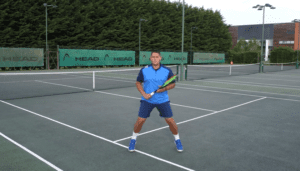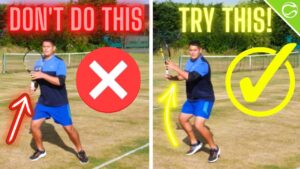
How To Hit The Perfect Tennis Forehand In 5 Simple Steps
How To Hit The Perfect Tennis Forehand In 5 Simple Steps
In this video Top Tennis Training coach Simon Konov will help you hit the perfect tennis forehand in five simple to follow steps.
The tennis forehand can be complex as there are so many aspects to focus on. The grip lays the foundation for your swing path and the style of forehand you will be able to hit so it’s crucial you find the correct grip to suit your game.
We recommend using the semi western forehand grip as this allows for good levels of topspin but also the ability to flatten out the tennis forehand shot if you want to attack.
Five Steps To The Perfect Forehand
1. Good Ready Position – Having a good ready position with the racket head higher than the grip level, holding the throat or grip with your non hitting hand and set up with the racket in the middle of your body will set you up perfectly for the rest of the stroke. Having a poor ready position will cost you valuable time and make the swing more complicated.
2. Unit Turn – As early as possible after you recognise the ball is coming to your forehand side, try to turn your upper body sideways onto the ball/net. This will be your left shoulder if you’re a right handed player. This unit turn will help you prepare the racket into the back position without having to swing as much with your arm alone and also engage the core muscles to help you have the coil – uncoil motion of the trunk later in the stroke.
3. Good Power Position – Reaching a good power or back position with the racket head higher than the grip level will create good leverage in the racket and arm. The non hitting hand should be across the body helping you balance the upper body but also tracking the oncoming ball.
4. Racket Lag – Creating a good racket lag where the head of the racket lags behind the grip will give you that leverage over the ball that you need for extra power and control. This action should happen naturally without forcing the wrist to bend, it should happen as a result of the stroke mechanics but also by setting up in a good power position, you set the foundation for creating good racket lag on the tennis forehand.
5. Good Follow Through and Finish – A poor follow through and finish can destroy the stroke but also lead to injury. During the contact zone, you want the racket to be accelerating and not slowing down, unless you’re absorbing power on the shot. For the most part you want the racket travelling through the contact point with good speed and you want to finish the follow through at the very end of the maximum swing path. A good finish will help the muscles relax in a natural way and reduce the risk of injury.



